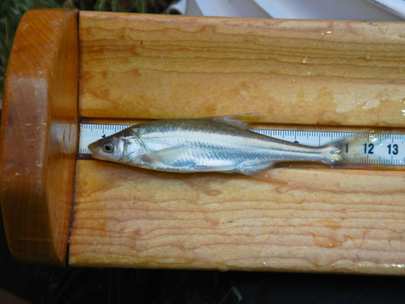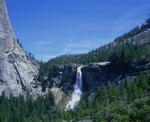Contact: Maureen Oltrogge, 928-638-7779
Contact: Brian Healy, 928-638-7453

Un-tagged juvenile humpback chub caught and released back into Havasu Creek (NPS photo)
Grand Canyon , Ariz. – National Park Service (NPS) biologists found spawning translocated endangered humpback chub (Gila cypha) in Havasu Creek during a recent fisheries monitoring trip that occurred between May 6 and May 15. This is the first time evidence of humpback chub reproduction has been found in Havasu Creek and marks an important milestone in the long-term effort to improve the species' odds of survival through the establishment of a second spawning population outside of the Little Colorado River within Grand Canyon.
Prior to the most recent monitoring trip, 543 juvenile humpback chub had been released in Havasu Creek between 2011 and 2012. During the 6 days prior to the 2013 translocation of 300 humpback chub to Havasu Creek on May 14th, NPS and U.S. Geological Survey – Grand Canyon Monitoring and Research Center (USGS-GCMRC) staff monitored the growth, survival, abundance, and spawning condition of previously translocated humpback chub. Ultrasound imaging equipment was also tested by USGS-GCMRC to determine if biologists could assess the spawning condition of these fish by examining female humpback chub for the presence of internally developing eggs, without sacrificing and dissecting the fish.
A high number of humpback chub were captured during monitoring efforts, including several males and at least two female humpback chub in spawning condition. Ultrasound images of the body cavity of several females appeared to show fully developed eggs, suggesting the fish were almost ready to spawn. Although further testing in needed, these results are promising and demonstrate the potential utility of ultrasonic imaging as a non-invasive method of evaluating spawning condition of this endangered species. Two juvenile humpback chub without identification tags (indicating they were not translocated previously) were also captured. The small size of these two un-tagged fish suggests they were hatched in Havasu Creek during the spring of 2012. Finally, a larval (newly hatched) fish tentatively identified as a humpback chub was captured. Confirmation of this species identification is awaiting evaluation in a laboratory setting. Together, these findings suggest that Havasu Creek humpback chub translocations have, at least to some extent, resulted in a spawning aggregation of humpback chub, but future monitoring is necessary to determine whether spawning leads to the survival of juveniles to maturity.
Fisheries biologists will continue to monitor the growth, survival, and reproduction of translocated humpback chub in Havasu Creek twice a year. Grand Canyon National Park Fisheries Program Manager Brian Healy said "We are all really encouraged by these results, although based on the high growth rates and retention of translocated fish we've seen during past monitoring trips, the detection of spawning fish this year wasn't totally unexpected. It will be really interesting to see whether spawning by these adult fish continues, and whether it leads to a larger number of juveniles and their survival to maturity."
Grand Canyon National Park Superintendent David Uberuaga said, "I'm excited about the humpback chub translocations. It is an important part of the park's efforts to protect its native fish species and the monitoring results will inform our park-wide fish management efforts."
Since 2009, the NPS and its cooperators (U. S. Bureau of Reclamation, U.S. Fish and Wildlife Service, the Arizona Game and Fish Department, and USGS-GCMRC, among others) have been translocating juvenile humpback chub from the Little Colorado River, which supports the largest remaining population, to other tributaries to the Colorado River within Grand Canyon National Park.
The humpback chub is an endangered fish species found only in the Colorado River basin. Although the humpback chub once flourished in the natural conditions of the Colorado River amid its warm turbid waters and seasonally fluctuating flows, it now faces serious declines associated with changes in habitat like the construction and operation of dams and the introduction of non-native fish species.
There are no closures at Havasu Creek related to translocation activities. Anglers should be familiar with the identifying characteristics of humpback chub to avoid any accidental capture of these endangered fish. Young humpback chub are silver, have small eyes and large fins, but have not yet developed the pronounced hump behind their head. If any humpback chub are incidentally caught, they must be immediately released unharmed.
For more information, please contact Brian Healy, Fisheries Program Manager at 928-638-7453 or Maureen Oltrogge, Public Affairs Officer, at 928-638-7779. Additional information on humpback chub translocations and Grand Canyon National Park's fisheries program is available online at http://www.nps.gov/grca/naturescience/fish.htm.


